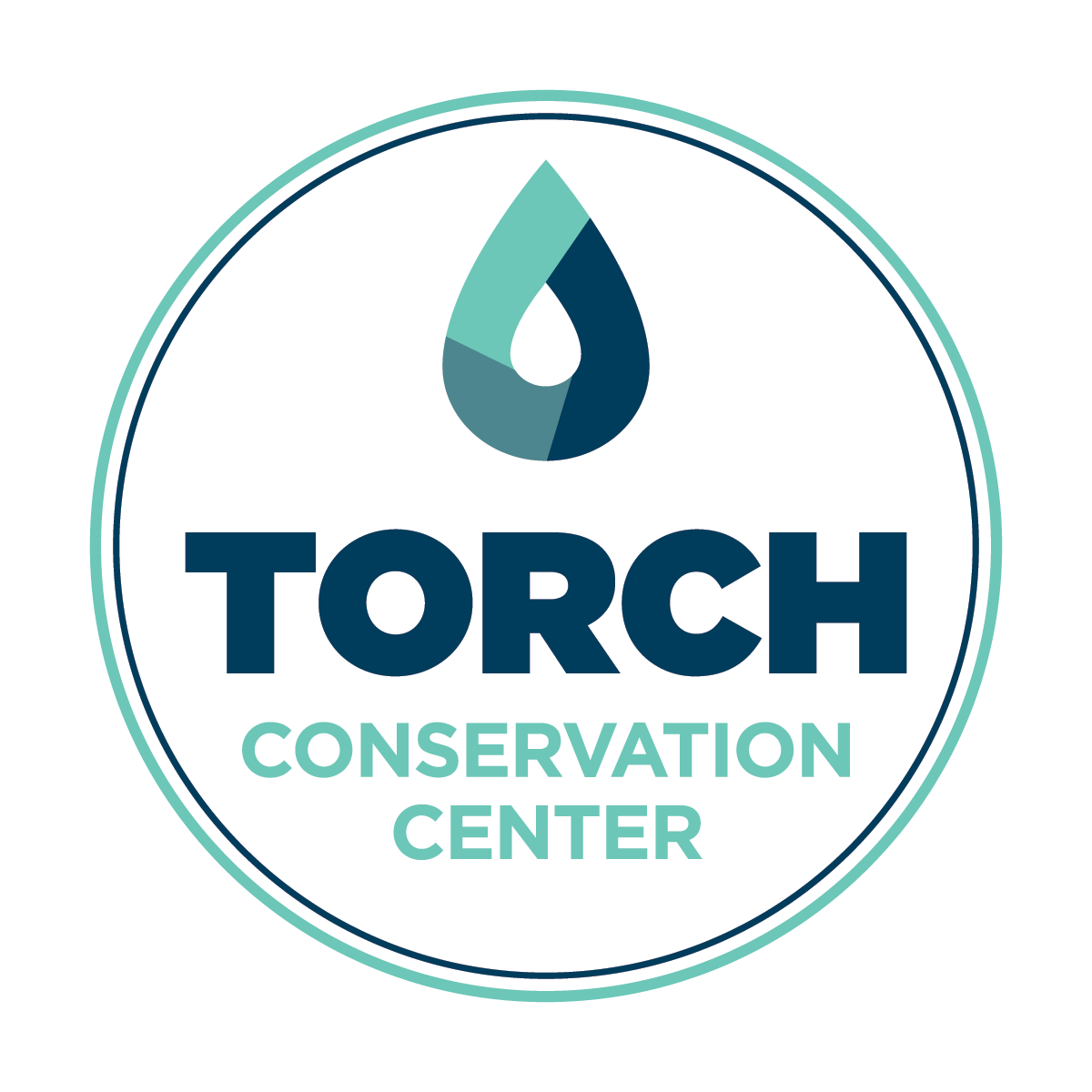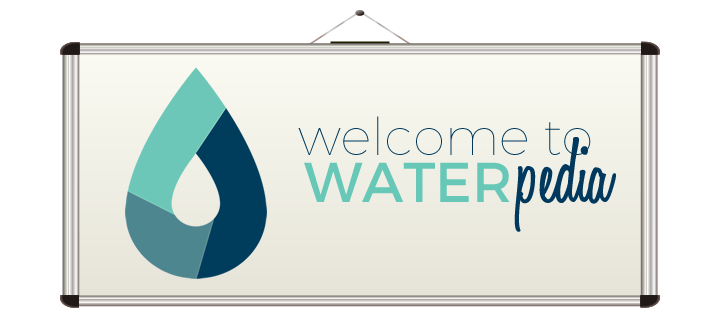
Groundwater
Groundwater is a limited resource!
Key Facts
- Good news — groundwater can be replenished by precipitation soaking down into the ground.
- Groundwater is freshwater stored below the Earth’s surface. In our watershed, it doesn’t collect in an underground lake. Freshwater fills in all the open spaces in the soil, sediment and rock underground.
- Groundwater feeds Torch Lake and its 47 tributary streams. When you feel a “cold spot” in the lake, you know you’ve hit a groundwater seep.
- People divert groundwater for many uses:
- more than 2,000 private well supplies homes in our Torch Lake Watershed with freshwater
- businesses & restaurants
- 101 farms
- natural gas exploration
Then & Now
THEN | people thought groundwater was protected by the soil above it.
NOW | we know groundwater is vulnerable to contamination from improper use and disposal of chemicals on the land above.
Did you know?
Groundwater Wells
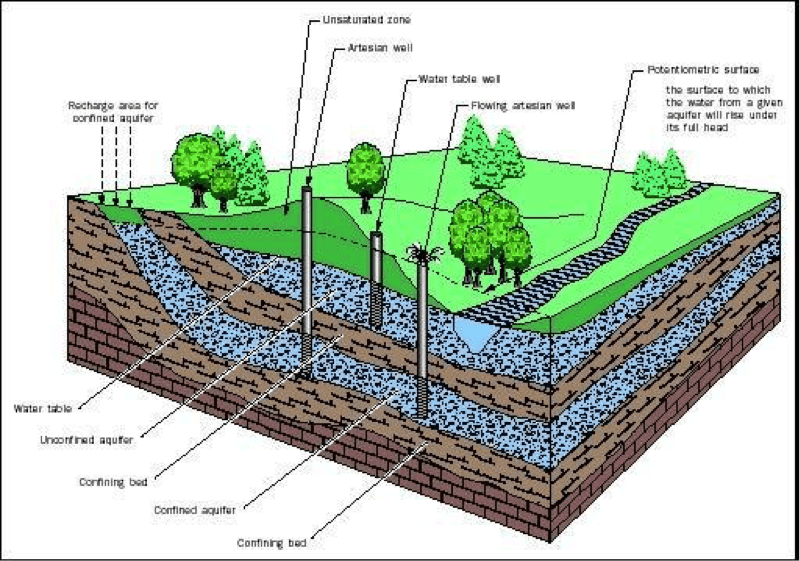
Image: Water Encyclopedia
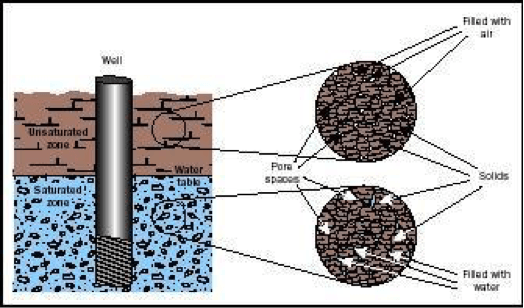
Image: Water Encyclopedia
Aquifer
- An aquifer is an area underground that stores water in permeable rock (shale & limestone), sand, gravel and soil.
- The Torch Lake Watershed aquifer has never been mapped, so we don’t know how large it is or how much water it holds.
- The Torch Lake Watershed aquifer is located far underground and is estimated to be 200 – 800 feet thick.
- The Torch Lake Watershed aquifer is unconfined. This means that water can pass through the layers above.
- These layers consists of a mixture of sand, gravel, rocks and clay called glacial till, left behind by the glaciers 10,000 years ago.
Artesian Wells
An artesian well occurs naturally when water is trapped under pressure between layers of permeable rock such as clay or shale. Pressure pushes the groundwater to the surface and creates a steady flow.
There are many flowing artesian wells in the Torch Lake Watershed.
Springs/Seeps
Springs and seeps are the headwaters of more than 40 streams flowing into Torch Lake. They are commonly found on hillsides where the water table intersects the surface of the land. Springs are also found on the bottom of Torch Lake. When you feel a cold spot in the lake, you know you’ve found a cold water spring.
Springs
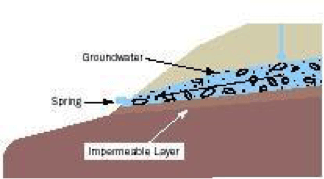
Image: Water Encyclopedia
Quicksand
Quicksand in Michigan is often found in wetlands near streams. Very fine grain sand particles are kept suspended in a spring, when the upward pressure of the water prevents the sand from sinking. Unlike scenes from old Tarzan movies, quicksand in our watershed is usually only a couple of feet deep.
Recharge Areas
Depressions and wetlands are two places where rainwater and snowmelt percolate down to the aquifer. It’s important to protect these areas in our watershed, so the aquifer is replenished.
More buildings, driveways and roads also means less land area is available for recharging or returning water to our common aquifer, too!
Water Table
The water table is the boundary between water-saturated ground and unsaturated bedrock below. The water table of an aquifer is not flat. There are high and low areas just like the hills and valleys found on land.
Withdrawals
A water withdrawal occurs when people drill wells into the aquifer and pump water out. As more people choose to live in our watershed, they drill more wells and withdrawn more water.
Discharge Areas
A discharge are is an area where water naturally seeps or flows out of the ground into a wetland, spring, stream or river to become part of a stream or the lake. These discharge areas need to be protected to keep our lake and streams clean and clear.
Show
You Care
We know you want to enjoy the lake for many years (and generations) to come. So, we’ve put together a list of simple steps you can take to reduce the nutrients, sediments and toxins flowing into the lake and its streams.
Test your well water.
Private water wells are not protected by the Federal Safe Drinking Water Act, so it is the responsibility of the property owner to check the water quality of the drinking water well. The Michigan Department of Community Health (MDCH) will test the well for bacteria, but not for other pollutants such as medicines, heavy metals (mercury), toxic substances (chemicals from pesticides and herbicides like atrazine), or VOCS (volatile hydrocarbons like methane, ethane and propane from oil & gas drilling). Contact a nearby lab, such as SOS Analysis, for this type of analysis.
Protect your drinking water.
Keep toxins and medicines out of the aquifer.
Gather automobile fluids, paint thinners, paint, varnish, pesticides, fluorescent light bulbs and batteries and other hazardous materials that contain toxins.
- Drop off hazardous materials on Antrim County Hazardous Waste Days. To make your drop-off appointment, call the Antrim Conservation District (231) 533-8363.
- Don’t flush medications down the drain into your septic system. The septic system cannot break down the chemicals, and the chemicals will end up in your drinking water. Return unused or expired medications (prescriptions and over the counter medicines) to any pharmacy.
Conserve water.
We tend to take our water for granted. We are surrounded by freshwater in our lakes and streams. Plus, we don’t have to pay for it when it comes from a private well. BUT, conserving water is important.
Install low flow toilets, because they reduce water use by 19%. More homes means more people are drawing water from the same underground source, our common aquifer.
WATERpedia: the “One-Stop Shop” for Water Science A-Z
A-E
F-M
N-S
T-Z
Don't just wish that Torch Lake will stay blue.
Choose a water-friendly lifestyle - make a difference!
